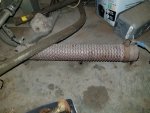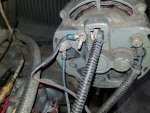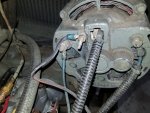- 16,794
- 24,148
- 113
- Location
- Burgkunstadt, Germany
Someplace there is a wire that sends DC voltage to the main gen to light it off. Follow the F1 and F2 wires backwards.
Steel Soldiers now has a few new forums, read more about it at: New Munitions Forums!

Someplace there is a wire that sends DC voltage to the main gen to light it off. Follow the F1 and F2 wires backwards.



The factory units teed the start switch held because it bypasses the low oil pressure shutdown. Since your unit is far from factory you can monitor what you would like. You really need to monitor oil pressure while running, on startup you should disengage the starter above the crank rpm, If you are slow to build oil pressure and the engine has fired but the starter is still engaged due to low pressure the starter will not have a good time. so in start sequence monitor rpm. as for oil pressure monitor it and there really needs to be a means of shutdown for loss of/ failed to make oil pressure.So the speed switch disconnects the starter solenoid and closes the "flash" relay? Makes sense.
So don't watch RPM, watch oil pressure? That's easy enough. I guess I could program the flash to last until the main is putting out some preset amount of voltage. I briefly read thru the programming guide for this controller but don't remember how it handles "if-thens". I would think that attaching conditions to a "programable output" is the definition of "programable output" so watching oil press before closing the "flash" relay should be pretty simple. It has dedicated inputs for oil press, coolant temp, fuel level and shore power monitoring.
Still not sure I need to do this but seems like an easy solution to "lighting it off".
Thanks for the input!
Sounds like you have already decided what you want to do for control system, but if things change, I wonder if this gen would be a good candidate for an SX-460 AVR?
I've used them a few times on different military gens and they have worked well every time.
Will that work? spec sheet calls for a minimum of 15 ohms. 004 field winding is 2-4 ohms.Sounds like you have already decided what you want to do for control system, but if things change, I wonder if this gen would be a good candidate for an SX-460 AVR?
I've used them a few times on different military gens and they have worked well every time.
| TEETH QUANTITY | 135 |
So the speed switch disconnects the starter solenoid and closes the "flash" relay? Makes sense.
So don't watch RPM, watch oil pressure? That's easy enough. I guess I could program the flash to last until the main is putting out some preset amount of voltage. I briefly read thru the programming guide for this controller but don't remember how it handles "if-thens". I would think that attaching conditions to a "programable output" is the definition of "programable output" so watching oil press before closing the "flash" relay should be pretty simple. It has dedicated inputs for oil press, coolant temp, fuel level and shore power monitoring.
Still not sure I need to do this but seems like an easy solution to "lighting it off".
Thanks for the input!

